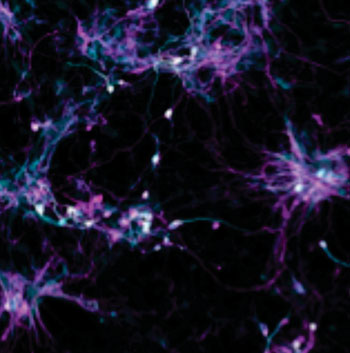Directly Differentiated Neurons Maintain Precursor Cells' Genetic Aging Pattern
By LabMedica International staff writers
Posted on 21 Oct 2015
Advanced stem cell techniques allow direct inducement of neurons that maintain the genetic pattern of aging that was present in the precursor skin fibroblasts and which may be used to model age-related neurological diseases.Posted on 21 Oct 2015
Investigators at the Salk Institute for Biological Studies (La Jolla, CA, USA) generated neurons from skin fibroblasts obtained from 19 human donors aged from birth to 89 years either by iPSC (induced pluripotent stem cell)-based reprogramming and differentiation or by direct conversion into induced neurons (iNs).

Image: A new technique enabled growth of aged brain cells from patients’ skin cells. The micrograph shows induced neurons that were directly converted from skin fibroblasts obtained from elderly human donors (Photo courtesy of the Salk Institute for Biological Studies).
Neurons derived by the iPSC method did not retain aging-associated gene signatures. On the other hand, use of non-viral plasmid transfection or protein transduction allowed the generation of induced neural precursor (iNP) colonies expressing a range of neural stem and pro-neural genes. Upon differentiation, iNP cells gave rise to neurons (iNs) exhibiting typical neuronal morphologies and expressing multiple neuronal markers including tyrosine hydroxylase and GAD65/67. Importantly, iNP-derived neurons demonstrated electrophysiological properties of functionally mature neurons with the capacity to generate action potentials. In addition, iNP cells were capable of differentiating into glial fibrillary acidic protein (GFAP)-expressing astrocytes.
The investigators reported in the October 8, 2015, issue of the journal Cell Stem Cell that while iPSCs and their derived neurons did not retain aging-associated gene signatures, iNs displayed age-specific transcriptional profiles and revealed age-associated decreases in the nuclear transport receptor RanBP17. They detected an age-dependent loss of nucleocytoplasmic compartmentalization (NCC) in donor fibroblasts and corresponding iNs and found that reduced RanBP17 impaired NCC in young cells, while iPSC rejuvenation restored NCC in aged cells.
"The neurons we derived showed differences depending on donor age,” said first author Dr. Jerome Mertens, a postdoctoral researcher at the Salk Institute for Biological Studies. "And they actually show changes in gene expression that have been previously implicated in brain aging. For instance, levels of a nuclear pore protein called RanBP17—whose decline is linked to nuclear transport defects that play a role in neurodegenerative diseases—were lower in the neurons derived from older patients."
Related Links:
Salk Institute for Biological Studies













